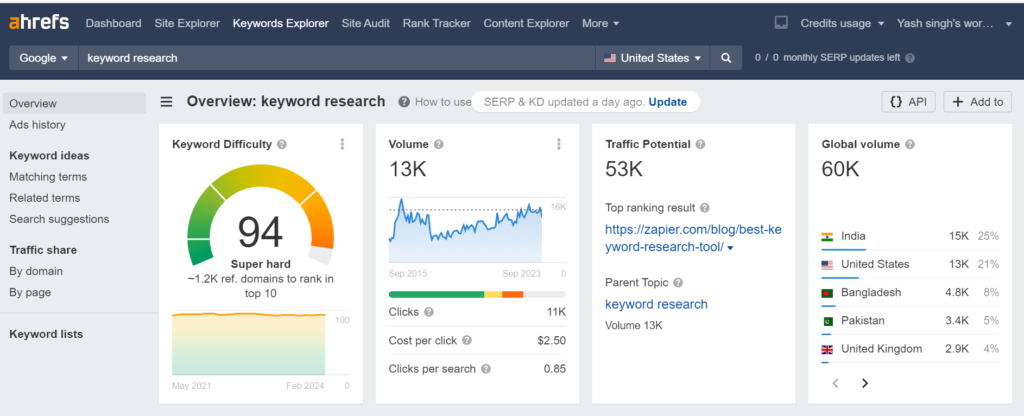Search engine optimization (SEO) is crucial in growing an online business today. With over 90% of all website traffic coming through search engines like Google, solid SEO directly impacts how many people can find and visit your site. This organic traffic is also more cost-effective in driving new leads and customers than other digital marketing channels.
Creating an effective SEO strategy for a business is complex and requires coordinating several key activities. At a high level, the most important components include:
Knowing the client’s objectives, target market, and line of business helps you decide which ROI KPIs to monitor. Recommendations should be based on assisting them in increasing rankings and conversions. Actionable opportunities include site speed, responsive design, and on-page optimization. Assessing existing organic traffic and rankings sets benchmarks.
Researching keywords for relevant opportunities. Keyword research tools help determine content optimization priorities by finding untapped long-tail keywords with good search volume. An SEO roadmap based on data. Success can be sustained while gaining momentum with an agile approach that balances short-term gains, steady progress over three to six months, and ambitious long-term goals.
Monitoring and reporting on ranking advancements. This measures the effect of SEO using essential metrics such as impressions, clicks, and conversions attributable to organic search. Accountability is upheld by highlighting optimization successes and improving underperforming projects.
This comprehensive guide will explore best practices for each step involved in creating high-impact SEO strategies explicitly tailored to clients’ business growth objectives.
Understand the Client’s Business and Goals
Gather Background on the Industry, Products/Services, and Competitors.
- Research the client’s industry vertical, standard practices, language, and market landscape
- For product companies – evaluate their product ranges, pricing tiers, shipping details, and competitive differentiation
- For service companies – analyze key offerings, certifications, specialties, and pricing models
- Identify 2-3 of their top competitors and benchmark SEO strategies and success metrics
- Audit competitor sites for technical health, backlinks, content themes, keywords targeted
- Recognize where there may be gaps in the market to capitalize on
Discuss Targets for Growth
- Have in-depth discussions around short and long-term goals
- Common targets include:
- Increase leads generated by 25% over 6 months
- Improve website conversion rates by 3-5% this quarter
- See 30% more organic traffic from search engines in a year
- Lock down specific revenue, lead generation or engagement objectives
Align SEO with Business Goals
- Ensure proposed SEO strategies map to broader business goals
- Show how specific ranking improvements, more traffic, and leads impact targets
- Gain buy-in by demonstrating how SEO initiates and supports the overall growth plan
- Adjust tactics based on any priority shifts or new objectives
Getting alignment on the industry landscape, competitor dynamics and the client’s vision for success ensures SEO efforts stay calibrated towards meaningful business outcomes rather than isolated tactical wins.
Conduct SEO Audit of the Website
Performing a detailed audit of the website’s current SEO health and fundamentals sets the benchmark against which to measure optimization efforts. Key areas to cover include:
Evaluate Technical SEO Factors
- Assess page speed performance and resolve any issues slowing down the site
- Confirm mobile responsiveness across site and content
- Check the indexing status of essential pages
- Review meta titles/descriptions, schema markup
Assess Traffic and Conversions
- Leverage Google Analytics to analyze traffic sources and visitor behavior
- Review goal conversion rates by channel to identify optimization areas
- Evaluate behavior flow of users coming from organic search
Analyze Keyword Rankings
- Use Ahrefs/SEMrush to compile a list of rankings for target keywords
- Identify current gaps in rankings vs. competitor performance
- Uncover new relevant keyword opportunities to target
Identifying the strengths to double down on and gaps needing attention provides direction for strategy. Technical problems negatively impact user experience, so addressing those is a priority. Competitor data also reignites inspiration for fresh SEO opportunities. The audit establishes a clear baseline of rankings and traffic to improve upon through planned optimization efforts in the coming months.
Extensive Keyword Research

Uncover Relevant Target Keywords
- Use multiple keyword research tools like Ahrefs, SEMrush, and Google Keyword Planner to discover relevant keyword opportunities for the target business.
- Research broad terms but also ensure long-tail keywords are considered, reflecting more specific customer intent
- Identify additional informational and transactional keywords beyond what the site may already be targeting.
- Look for keywords competitors may be missing optimization opportunities on
Analyze Volume and Competition
- Review monthly search volumes for each discovered keyword opportunity
- Assess historical trends and seasonality shaping search behavior
- Evaluate keyword difficulty scores reflecting ranking competitiveness
- Benchmark existing authority (domain/page) metrics for site vs. competitors
- Identify terms aligned to business goals by volume and intent
Group Into Priority Tiers
- Categorize researched keywords into A, B, and C groupings or tiers
- Tier A represents the highest conversion value targets to guide content pillars
- Tier B keywords have good volume + intent – optimize for core site pages
- Tier C niche long-tails – match dynamically across the relevant site content
Thoughtful prioritization ensures energy is focused on terms with the best ROI potential while optimizing for full-funnel relevance. This drives strategy and resource allocation.
Build Ongoing SEO Roadmap
Short and long-term focus areas
- The SEO roadmap balances quick wins and longer-term success markers.
- Short-term priorities fix pressing technical issues and pursue low-hanging fruit opportunities.
- The long-term strategy targets ambitious rankings growth for competitive keywords.
Projected milestones and timeframes
- The roadmap outlines specific goals and target completion dates
- Milestones provide motivating progress markers at set intervals
- Example milestones over 6 months:
- Resolve critical technical issues (Month 1)
- Achieve first page rankings for 3 target keywords (Month 3)
- Build domain authority to 50 (Month 6)
Detailed strategies for on-page content and links
Granular plans are created for focus areas like:
- On-page optimization detailing priority pages and content gaps.
- Link building tactics mixing earned outreach and partnerships.
- Content development mapping assets to keywords/funnel stage.
- Local SEO expansion listing claimed profiles.
Having clear objectives, success markers at set times, and tactical plans. This comprehensive roadmap acts as the SEO strategy guiding day-to-day efforts. It sets targets to work towards while adapting based on evolving business needs.
Track, Report and Refine

Key metrics to illustrate ROI
Define and report on key metrics each month demonstrating optimization success including:
- Total organic traffic, YoY comparisons
- Click through rates from rankings
- Lower bounce rates signaling relevance
- Increased pages per session
- Conversions and sales from SEO referrals
Dashboards to Showcase Progress
Provide dashboards and scorecards covering key indicators like:
- Overall search visibility via rankings
- Ongoing gains for target focus keywords
- Links acquired and placements over time
- Content engagement and metrics
Optimize Efforts Based on Data Insights
Learn from previous month’s data to enhance efforts:
- Identify high-performing keywords and pages to double down on
- Review landing pages underperforming on bounce rate or conversions
- Look for gaps in rankings revealing opportunities
- Reallocate resources/budget towards top-ranking content
Closely tracking defined success metrics provides accountability. Presenting progress in executive dashboards quantifies the impact over time. This allows for celebrating wins while addressing underperformance. Continually optimizing the roadmap based on insights maintains relevance.
Benefits of a Tailored SEO Strategy
Investing in a customized SEO strategy tailored to a business’s specific goals and audience offers significant advantages over a one-size-fits-all or DIY approach.
The benefits of an optimized SEO campaign include:
Increased Organic Traffic:
A strong SEO strategy focuses efforts on rankings for keywords driving qualified traffic. Improvements result in exponential website growth as more visitors discover content on search engines daily.
More Conversions and Sales:
Higher conversions follow increased relevant traffic to the site. A 200% increase in organic visitors means 200% more chances to convert traffic into leads and customers.
Enhanced Brand Visibility & Trust:
Appearing on the first page for industry keywords builds authority and trust. More searchers seeing high-quality content increases awareness and credibility.
Greater Cost Efficiency:
Reaching interested people via SEO is far more affordable than paid advertising for the exact keywords. Growing organic channels reduces overall marketing spending long-term.
Supports Wider Objectives:
SEO success positively affects email marketing, social media, PR and other initiatives – driving engagement across channels.
Sustainable Competitive Edge:
Matching SEO best practices to business goals establishes an ongoing search visibility advantage that is difficult for competitors to replicate quickly.
A strategic SEO approach is essential for predictable, sustained growth – not quick wins. Increasing traffic, brand muscle, cost-efficiency and competitive differentiation add tremendous value to any online business.
Conclusion
In closing, developing a tailored SEO strategy custom-fitted to a client’s specific business goals and target audience is crucial for making meaningful and sustainable progress. While technical factors and best practices provide a strong tactical foundation, the most significant wins come from a customized approach.
The process begins by intimately understanding a client’s industry, competitors, products, and customers. This knowledge informs well-researched keyword opportunities to focus time and resources on. Granular SEO roadmaps outline short and long-term prioritization, balancing quick returns and ambitious targets. When crafted considering the client’s unique value proposition and market dynamics, the SEO strategy drives relevant traffic, conversions and repeat business. Rather than generic recommendations, customized strategies reflect a consultative approach that puts the client’s needs first.
The deep level of personalization pays dividends through visibility gains directly answering the search intent of their potential customers. Custom SEO game plans in competitive markets provide the best vehicle for long-term growth.

